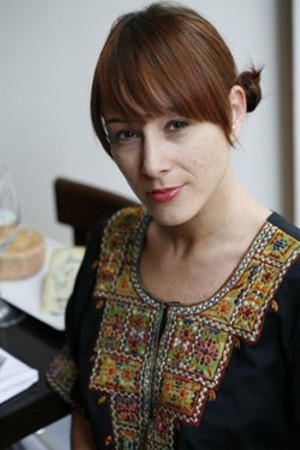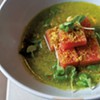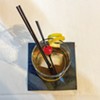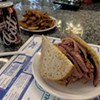Published May 4, 2010 at 4:23 p.m.
Growing up in a working-class town on the South Shore of Long Island in the 1980s, Tia Keenan ate all the cheeses one might expect: Muenster, American and cheddar from the Cracker Barrel.
Fast-forward a few decades. Keenan, 34, has established some serious cheese cred. Once a self-described “super-picky kid,” she now makes a living introducing people to everything from smears of fresh, delicate curd to wedges of stinking, oozing washed rind. Her signature is matching the country’s finest artisan offerings with handmade, seasonal condiments: Think mascarpone with a licorice-cranberry spritzer or a piece of nutty sheep cheese with a coffee marshmallow.
Keenan got into the cheese biz via French cuisine. While working at a restaurant called Fleur de Sel, she was called on to source fromage for one of the eatery’s investors and regular customers, who preferred it to sweet desserts. Later, with plenty of sampling under her belt, she was hired to establish and run what she calls a “very classic, Eurocentric” cheese program at The Modern, an upscale restaurant located inside New York’s Museum of Modern Art.
In 2006, Keenan helped a friend open a small Manhattan restaurant and wine bar called Casellula Cheese and Wine Café, where she had carte blanche to develop her unique style. There she experimented with artistic cheese plates on which each slab or scoop had its own appropriate accompaniment. She likens this bite-sized approach to the making of perfect, jewellike pieces of sushi.
Now a consultant and educator with a new restaurant in the works, Keenan is pondering ways to push America’s relationship with cheese to a new level, a concept she refers to as “Cheese 3.0.”
On Wednesday, May 19, at The Essex: Vermont’s Culinary Resort & Spa, the extraordinary fromager will walk 50 lucky Vermonters through a pairing of eight local cheeses with some of her uncommon condiments. We decided to ask her what inspires them.
So, you work in restaurants but have a journalism degree?
I grew up thinking I would be an artist. My initial [college] concentration was in graphic art and printmaking, but when I went to art school I thought it was, frankly, too bullshitty. I found the journalism department because I was looking for where the action was and where the movement was. This was the mid-’90s, and there was an Internet revolution happening.
How has your background in art and the media informed your approach to cuisine?
I think the role of an artist in society is as a communicator — someone who shows people a different point of view, who creates new ways of seeing.
What draws me to food is what drew me to writing and painting. Food is another way of communicating, and it’s a way I really love because there’s something populist about it: You’re communicating using a medium that’s essential to people’s survival.
What is it you’re trying to communicate?
I’m trying to encourage wonder and curiosity, what we might call childlike qualities. There isn’t a spiritual life with food in this country — we eat a lot of processed foods that are really disconnected from nature.
Food is the intersection of everything that’s important to human beings: It has the ability to express how we feel about ourselves, our families, our communities and the planet. It expresses personal taste. It tells us about beauty. It’s something that connects us to human beings 2000 years ago. It’s primal. The first thing we do when we come out of the womb is, we suckle. We eat. When you serve food, you’re tapping into the earliest memories of the person you’re feeding.
What’s really fantastic as an artist is that you can take all of these heavy concepts and ideas and try to express them on the plate, and then it literally turns into shit. It’s the most meaningful thing and the most meaningless thing.
I’ve heard you mention a connection between cheese and sushi. Can you explain?
I’ve always been interested in the aesthetic of sushi. I once went to Masa as a guest. There were three sushi chefs, including Masa himself. Each was making sushi for two people, and they were synchronized — they would all slice the fish or put on the wasabi at the same time. I was literally almost crying, thinking, This is so beautiful … Martha Graham would have liked this. It was sushi ballet.
A big part of the experience was looking at the color and the geometry of [each item] before eating it, and I remember thinking, This is what my work aspires to. I want people to look at it and have questions about it before they eat it. I want it to be a visual experience, and I want some mysticism there.
What compels you to eat cheese in a restaurant?
If there’s a cheese I haven’t had, I’ll definitely order it, but that’s rarer and rarer. If I see something I really love that I haven’t had in a while, I’ll want to retaste it. Or if I think it’s going to be an interesting plate. But I eat too much cheese in my creative work life to really eat much at the hands of other people. My cheese fantasy world exists in my own head. I don’t see much else that compels me.
Describe your upcoming restaurant.
It will be Cheese 3.0. The artisan cheese revolution began in the ’80s with a bunch of people, mostly women, making goat cheese. They were pioneers. I think of that generation as Cheese 1.0. What I did at Casellula was Cheese 2.0: We [asked questions such as], “What is an American cheese experience?” “How do we teach people about cheese?”
Now, customers [in New York City] don’t need to be told everything. They expect artisan cheese; they understand the cycle of food and that food is the connection between rural and urban economies; it’s a given that the best food is handmade. Five years ago, the average NYC diner didn’t know that.
[The new restaurant] is going to be much more DIY. There will be participation on the part of the guest in the actual creation and making of the food. It plays on questions like, “Who is the diner?” “Who is the maker?” and “How do we all intersect in a meal?” It looks toward Asia for its aesthetic.
And the new restaurant will have 100 percent American cheese.
When you’re eating cheese, do you prefer to pair it with wine or beer?
I think they both go really well. My fiancé, who is a sommelier, is whispering, “Beer, beer, beer.” I do think beer has the upper edge, because cheese really coats your tongue, and the carbonation of beer or champagne acts like scrubbing bubbles. I think sake is interesting, too.
The reason we always think of cheese with wine is that often our limited experience with fancy cheese is [with] French cheese and French wine in French restaurants. But stylistically, it just depends.
How do New York City foodies view Vermont dairy products?
I think New York City foodies worship at the udder of Vermont. In Wisconsin, their background is in industrial cheese. In California, you have a blend — you have industrial cheese being made and a tradition of artisan cheesemakers that spans 30 years. The most industrial you get [in Vermont] is Cabot. In terms of artisan cheesemaking, you guys have it in the bag. People are totally curious about Vermont cheese. I think they’re voracious and want more and more of it.
How about their vision of the state as a whole?
There’s some idealism. I think [New Yorkers] have the Ben & Jerry’s image of Vermont as this green, pastoral place with Holsteins. I don’t think they understand how harsh and difficult the Vermont landscape really is.
The reality of Vermont that I know is, “Goddamn, it’s cold. I can’t believe people farm here.” Urban people don’t know how hard the farming life is, and don’t understand how amazing it is that a place like Vermont makes such great milk.
The story that sells [Vermont’s image], whether right or wrong, is ultimately lacking in nuance. It’s a service and a disservice at the same time.
Have any dining experiences you’ve had in Vermont stood out?
I love Bluebird [Tavern]. It really embodies the localvore movement in the most down-home way, without any pretense. I love the stripped-down feel of it. It’s brilliantly executed and soulful. When I went there, I took the menu home with me. Whenever I take the menu home, you know I’ll be your customer for a long time.
And I love The Woodstock Inn [& Resort], because one of the most talented chefs I’ve ever worked with works there and does really beautiful, simple, super-high-quality, elegant food. In a place like a hotel, it’s often hard to show that love, and I think he does that there.
Want a taste?
Meet Tia Keenan and try her creations at “Trough to Table: Celebrating Vermont Cheeses With Tia Keenan,” Wednesday, May 19, 6 p.m., The Essex: Vermont’s Culinary Resort & Spa, $40 per person. To register, call 878-1100.
Come and Get It!
One day it’s snowing; the next day half the population of Burlington is dining al fresco on Church Street. What better time to call attention to Vermont restaurants? This week, Seven Days publishes its annual dining guide, 7 Nights. Next week, from May 14 to 20, the paper presides over the state’s first Vermont Restaurant Week. More than 50 area restaurants — from St. Johnsbury to St. Albans — are offering prix-fixe deals in an effort to make dining an affordable adventure for everyone.
The concept has taken off in hip food cities such as Seattle and New York City. We couldn’t let the land of artisan cheese, microbreweries and community-supported agriculture be last to the table.
What does Vermont Restaurant Week mean for diners? At Junior’s Italian in Colchester, 15 bucks could buy you a salad, spaghetti and meatballs, and cannoli. At Café Shelburne, $35 could get you mussels in puff pastry, duck confit with potato gratin and chocolate fondant with pistachio crème anglaise.
But there’s more to it than gorging on delicious dishes. At The Essex: Vermont’s Culinary Resort & Spa, a panel discussion of local and imported luminaries digs into what makes Vermont products and restaurants special — and what opportunities we’re missing.
What’s dinner without a movie? The Food & Wine Film Festival at Merrill’s Roxy Cinema should give diners plenty to chew on with showings of the documentaries Fresh and Food, Inc., as well as foodie-friendly fiction films.
Other events help food lovers expand their tastes along with their perspectives: a wine dinner at 156 Bistro in Burlington, a spread of craft beer and gastropub fare at Montpelier’s Three Penny Taproom, and a pairing of artisan cheeses with unique condiments at The Essex.
To whet your appetite, this issue of Seven Days digs into the subject of food. More and more, local eaters are going public about their palates. Alice Levitt sought out seven “citizen reviewers” who post critiques on our 7 Nights website and discovered what drives them to praise — or knock — an eatery. For advice on what makes a useful online review, we turned to Lara Dickson, owner of graphic- and web-design biz Deep Dish Creative.
Suzanne Podhaizer spoke with two out-of-state gourmets visiting for Restaurant Week: Chef Rob Evans, who will appear on Saturday’s panel, and fromager Tia Keenan, the artist behind what promises to be the most unusual cheese pairing the state has ever seen. Both are big fans of Vermont’s culinary culture.
Want more? Andy Bromage commandeered a table at “Vermont restaurant central” — Leunig’s Bistro — so he could interview the maître d’.
A meaty insert provides detailed menus for each participating restaurant, as well as a full calendar of Restaurant Week events.
More By This Author
Speaking of...
-

Middlebury's Champlain Valley Creamery Marks 20 Years With a Milestone Cheese
Feb 27, 2024 -

Q&A: Howard Fisher Delivers Meals on Wheels With a Side of Good Cheer
Dec 20, 2023 -

Video: Howard Fisher Delivers Meals on Wheels
Dec 14, 2023 -

Q&A: Alexis Dexter Rescued 57 Shelter Cats During the July Flood
Sep 13, 2023 -

Video: Two Months After the Flood, Alexis Dexter Rebuilds Kitty Korner Café in Barre and Continues to Rescue Cats
Sep 7, 2023 - More »
Comments
Comments are closed.
From 2014-2020, Seven Days allowed readers to comment on all stories posted on our website. While we've appreciated the suggestions and insights, right now Seven Days is prioritizing our core mission — producing high-quality, responsible local journalism — over moderating online debates between readers.
To criticize, correct or praise our reporting, please send us a letter to the editor or send us a tip. We’ll check it out and report the results.
Online comments may return when we have better tech tools for managing them. Thanks for reading.














































